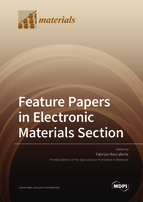Feature Papers in Electronic Materials Section
A special issue of Materials (ISSN 1996-1944). This special issue belongs to the section "Electronic Materials".
Deadline for manuscript submissions: closed (31 December 2021) | Viewed by 79177
Special Issue Editor
Interests: wide band gap semiconductors (WBG); silicon carbide (SiC); gallium nitride (GaN); gallium oxide (Ga2O3), metal/semiconductor and metal/oxide/semiconductor interfaces; Schottky diode; JBS; MOSFET; HEMT; WBG device processing; power- and high-frequency electronics
Special Issues, Collections and Topics in MDPI journals
Special Issue Information
Electronic materials are widespread in modern society. For example, communication devices, power supplies, energy conversion systems, computers and wireless systems, solid-state lighting devices, sensors and detectors, etc. are commmonly used in daily life and are often based on a variety of electronic materials with specific functionalities.
Clearly, the comprehension of the fundamental properties of these materials, the development of their processing technology, and their integration in real devices require continuous efforts from the scientific community.
This Special Issue on "Feature Papers in Electronic Materials Section" aims at collecting the most recent advances on electronic materials and devices in different fields of interest (e.g., nanotechnology, power- and high-frequency electronics, optoelectronic devices, sensors). For that reason, this Specail Issue will include a large variety of materials and related device technologies, such as nanostructures, binary and complex oxides, gate insulators, metallizations (Schottky, Ohmic), conventional semiconductors (Si, Ge, SiGe, GaAs, etc.), wide band gap semiconductors (SiC, GaN, Ga2O3, ZnO, AlN, diamond, etc.), heterostructures, nanowires, 2D materials and compounds (graphene, hexagonal boron nitride, transition metal dichalcogenides, etc.), optical and energy harvesting materials, etc. In addition, the development and application of advanced characterization techniques to electronic materials and devices are also in line with the scope of the SI.
The submission of regular articles and review papers on the above electronic materials and related devices is welcome.
Dr. Fabrizio Roccaforte
Guest Editor
Manuscript Submission Information
Manuscripts should be submitted online at www.mdpi.com by registering and logging in to this website. Once you are registered, click here to go to the submission form. Manuscripts can be submitted until the deadline. All submissions that pass pre-check are peer-reviewed. Accepted papers will be published continuously in the journal (as soon as accepted) and will be listed together on the special issue website. Research articles, review articles as well as short communications are invited. For planned papers, a title and short abstract (about 100 words) can be sent to the Editorial Office for announcement on this website.
Submitted manuscripts should not have been published previously, nor be under consideration for publication elsewhere (except conference proceedings papers). All manuscripts are thoroughly refereed through a single-blind peer-review process. A guide for authors and other relevant information for submission of manuscripts is available on the Instructions for Authors page. Materials is an international peer-reviewed open access semimonthly journal published by MDPI.
Please visit the Instructions for Authors page before submitting a manuscript. The Article Processing Charge (APC) for publication in this open access journal is 2600 CHF (Swiss Francs). Submitted papers should be well formatted and use good English. Authors may use MDPI's English editing service prior to publication or during author revisions.
Keywords
- electronic materials
- device processing
- power- and high-frequency electronics
- optoelectronics
- sensors
- detectors
- semiconductors
- wide band gap materials
- graphene and related 2D materials







